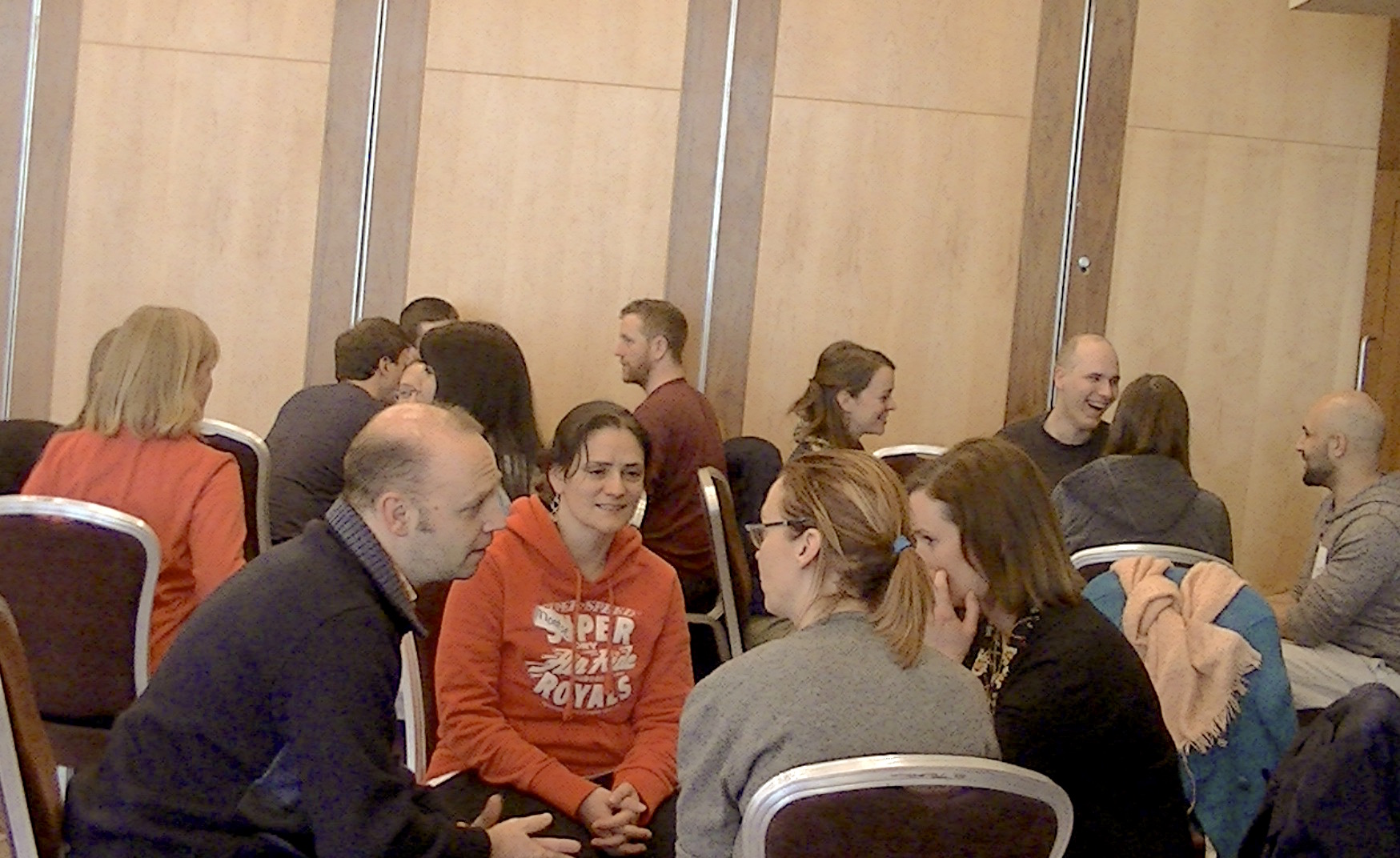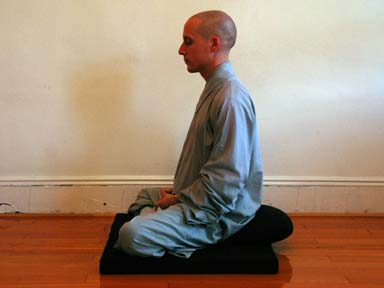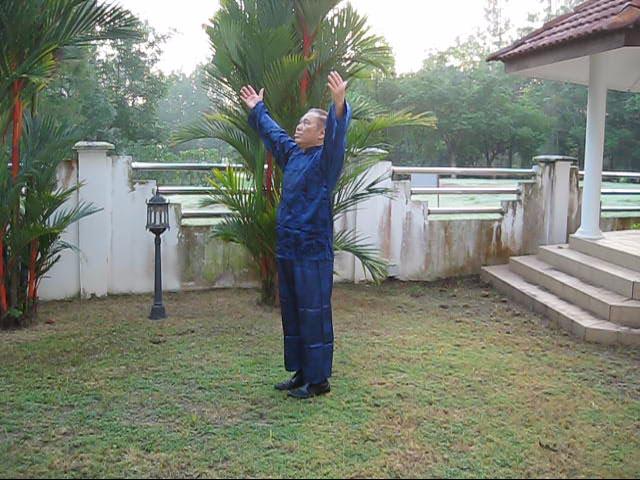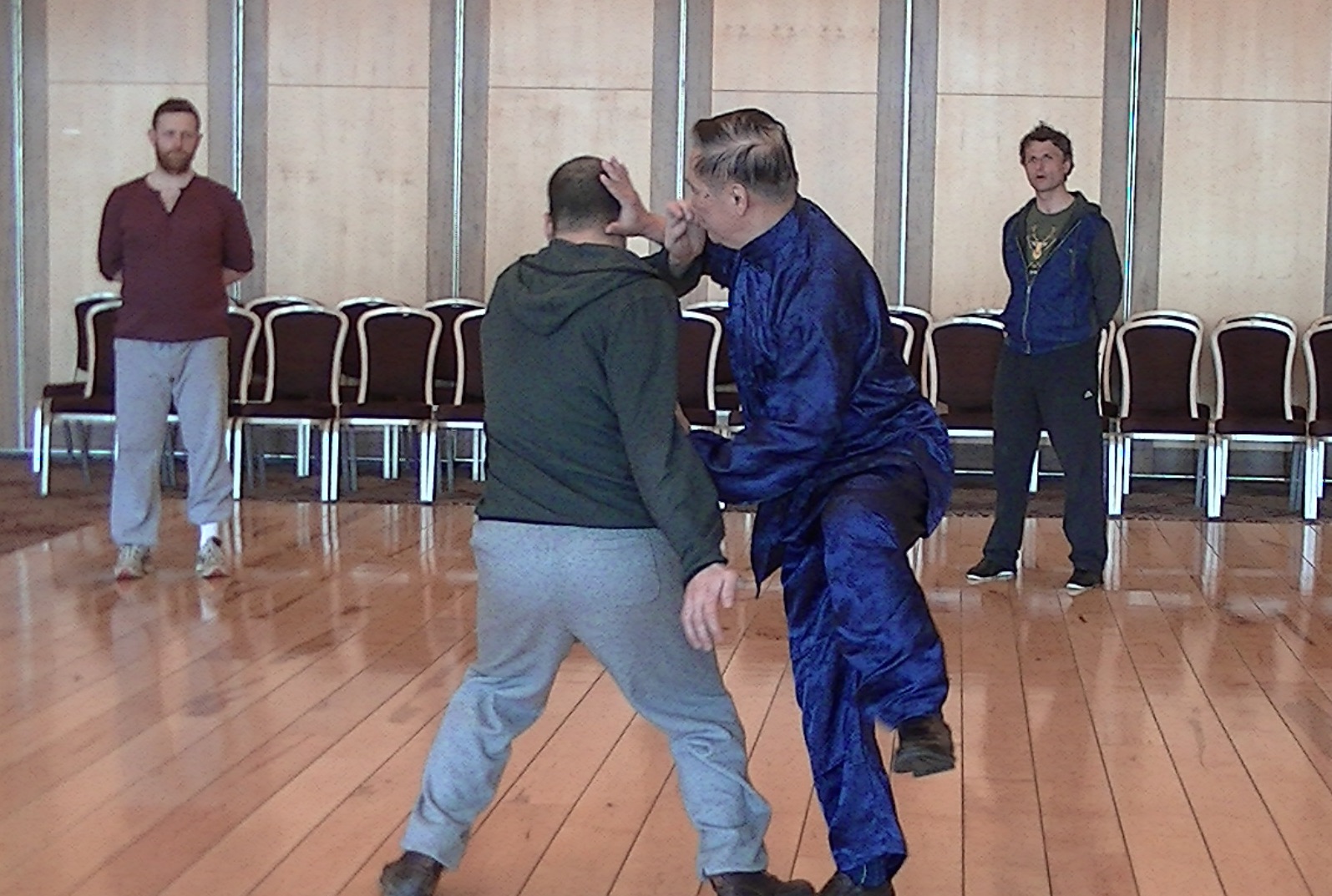SELECTION OF QUESTIONS AND ANSWERS
APRIL 2017 PART 3

Participants using a Zen mind to solve problems during a Zen Course in Dublin 2016
Question 1
Sigung,
Your exposition of the three bodies of the Buddha was so beautiful. The clarity you delivered the speech with was outstanding and really helped me to put your teachings into context. Thank you for dispelling my ignorance!
— Olli, Finland
Answer
My explanation of the triple-body of the Buddha, which corresponds to the trinity concept in Christianity, is an example of being simple, direct and effective, the three fundamental qualities of Zen training.
Question 2
I wanted to ask a few technical questions regarding dhyana states and the Theravada tradition's emphasis on Stream Entry as different ways of measuring meditation success. I am certain that many will benefit greatly from your crystallized thoughts on the topic.
Answer
The eight dhyana states and the concept of stream-entrance are found not only in Theravada Buddhism but also in Mahayana Buddhism and Vajrayana Buddhism, i.e. in all Buddhism.
The eight dhyana or meditation states and their chief characteristics are as follows.
- 1st dhyana -- absence of desires
- 2nd dhyana -- joy
- 3rd dhyana -- non-attachment
- 4th dhyana -- awareness beyond thought
- 5th dhyana -- boundless space
- 6th dhyana -- pure consciousness
- 7th dhyana -- pure emptiness
- 8th dhyana -- beyond perception and non-perception
In Chinese these eight meditation states are known as "si chan ba ding", or four meditative states and eight stillness states. Please note that there are eight states, not twelve. The four meditative states are the same as the first four stillness states.
Stream entry means entering the stream, or teaching of the Eight-Fold Path towards Enlightenment. In the world context of many religions, it means starting spiritual cultivation. It is a remarkable achievement, as many people may take many life times before they can enter the stream.

Meditation to attain various dhyana states. The picture is taken from http://www.ddmbasf.org/chan-practices
Question 3
The classical Buddhist teachings tell of eight dhyana states that the meditator may cultivate in their pursuit of Enlightenment. In the Intensive Zen Course I felt sensations of pleasure surge within me during the first sitting meditation when we focused on the single-pointed mind. Am I correct in assuming that this was approaching some form dhyana realm which is most often associated with rapturous pleasure and joy?
Then during the attaining of no-mind and expansion to the Cosmos, practitioners could have either feft the vastness of space or consciousness, no-mind, or the peak of cyclic existence where there is both or neither mind and no-mind. Am I correct with my assessment and that these relate to the formless realms?
Answer
Yes, in the meditation during the Zen course when you felt surges of pleasure within you, you had entered into the second dhyana state of joy. In another meditation when some practitioners experienced that they were nowhere and everywhere, they had entered higher dhyana states of boundless space and pure consciousness.
Here we use the paradigm of eight dhyana states to describe various Zen state of mind. It should be noted that describing various meditative states as eight dhyana states is a paradigm, just as, in a more prosaic situation, describing various types of food as proteins, carbohydrates, fats and vitamins is a paradigm.
A paradigm is a special way of perceiving things and events; it is not a statement of absolute facts. Many people, for example, may not use the paradigm of classifying food as proteins, carbohydrates, fats and vitamins. The traditional Chinese and Indian classify food as just hot or cold.
Hence, in the paradigm of Zen, which was also the paradigm we used in the course, we did not classify meditation into eight dhyana states; we just classified attaining a one-pointed mind or attaining no mind.
Using the eight dhyana states as a cultivation approach takes a much longer time, usually many life times. Using the Zen approach is regarded as sudden, where one may attain Enlightenment in an instant. When a Zen practitioner attains no mind, which is all mind, be becomes a Buddha instantly, or merges with God the Holly Spirit.
In our case, we want to return to our phenomenal world where we work and live. So we just had a glimpse of the Original Face, or God the Holly Spirit, and returned to our dan tian.
Question 4
I have read of some highly advanced meditators (Theravada Arhat) reaching 5 Pure Land states fairly easily through meditation. I am adding a description of them I found in the Internet for your convenience in the end of my message. Are these 5 extraordinary meditative states familiar to you?
These are so advanced skills that I would not post the descriptions anywhere except enclosed in private correspondence, and neither do I plan to try accessing them in the near future.
Answer
Yes, these meditation attainments are familiar to me, though we may describe them using different words. Many of our instructors and students have had these experiences.
These are advanced skills and should not be attempted on their own by people without the supervision of a master, but many of our instructors and students have attained them. We are able to attain these attainment in a ridiculously fast manner because we use the Zen approach. Others who use traditional approaches may take many years, or life times.
Understandably, other people may not believe in our claims. Some may become angry. As I have often said, that is their business. But you yourself have direct experience of our claims. You are a relative beginner, and I believe the Zen course in Dublin was the first you took. Yet, you attained the second dhyana state of meditation. Others would take many years.
Editorial Note: Olli's other questions are found in the next issue May 2017 Part 1 of the Question-Answer Series.

Two Aspects of Yin Yang
Question 5
Regarding Taijiquan, may I ask you the difference between "Gathering the Cosmos" and "Two Aspects of Yin Yang".
— Sifu Tim Franklin, United Kingdom
Answer
"Gathering the Cosmos" and "Two Aspects of Yin Yang" are the same pattern but given different names. "Gathering the Cosmos" or "Gathering Chi from the Cosmos" was the term I used to describe a pattern where I used my two hands to gather cosmic energy from the Cosmos into my dan tian.
In Wudang Taijiquan, the name of this same pattern from a classic was called "Two Aspects of Yin Yang". I believed the name followed the first pattern, "Cosmos One Energy", where a practitioner stood at a Wuji Stance, or a No-Boundary Stance. The two beginning patterns suggested that this was how Wuji, or the Great Void, gave birth to the Cosmos, or Taiji. First there was nothing, called the Great Void. Then there was yin and yang. The interaction of yin and yang gave rise to myriad things.
"Gathering the Cosmos" or "Two Aspects of Yin Yang" is also called "Chi Focused at the Dan Tian" in some chi kung literature. There is, however, some difference. In "Chi Focused at the Dan Tian" or "Chi to the Dan Tian", practitioners may perform the pattern the same as "Gathering Chi from the Cosmos" or just stand at the Wuji Stance and mentally let energy be focused at the dan tian.
These same patterns are not found in Taijiquan only but in other styles of kungfu too, especially at an advanced level where nei gong and meditation, or internal art and spiritual cultivation, are practiced. But these patterns are particularly important in Taijiquan, which is an internal martial art. However, most Taiji practitioners today merely perform the outward forms of the patterns, missing their significance.
Question 6
In this morning practice, after standing in Wuji I felt chi rising to the top of my head and to the inside of my forehead. I then performed "Two Aspects of Yin-Yang" a number of times.
The next moment an aspect of me was floating away from Earth, looking down watching the Earth become smaller and smaller, until there was nothing. It was both enjoyable and interesting. This is why I asked the question of the difference, as something seemed to have shifted today.
Answer
Congratulations, you have attained a very high level of spiritual cultivation. In Taoist cultivation, it is known as "ling hun chu qiao", which means "the spirit going out of the body". In the past it was attainable by great masters who had trained for at least 20 years. For further cultivation, the aspirant would become an immortal and roam the heavens. In modern times very few masters, even genuine ones, would have attained this level.
It is incredible but your attainment is no surprise as, considering the cost-effectiveness in our school, you have been training for more than 12 years.
But you and no one in our school want to leave our phenomenal world now. Hence, you return to our world with a thought of chi being focused at your dan tian. The experience is life-changing. Life will not be the same again. Everyday will be a joy.

A sophisticated pattern from the San Feng Wudang Set that many people may not know its combat application
Question 7
In reference to the various Taijiquan sets we have in our school, how do the sequences of the San Feng set fit in, in terms of fulfilling the four aspects of form, force, application and philosophy.
Answer
All the sequences in the San Feng Wudang Set are advanced. A very good way to judge how advanced the patterns in a set are, is to find out their combat application. Most people would be unable to tell the combat application of most of the patterns in the San Feng Wudang Set. As a comparison, many people would have no difficulty finding out the application of the patterns in a simple set like Four Gates.
It is difficult to find out the combat application of the patterns in an advanced set because the combat application of these patterns, which have gone through a long period of history, have evolved from being simple to being sophisticated. At first their functions were merely those of punching, kicking and warding off, but as they evolved their functions became sophisticated. Many uninitiated persons may think the patterns flowery. The combat application of the patterns in an elementary set, on the other hand, are obvious.
The patterns in the San Feng Wudang Set are not just for combat, they are also effective for generating chi flow and internal force. This is another effective way to tell an advanced set from a simple one.
In a simple set like Four Gates, practitioners have to employ supplementary methods to increase their force, like hitting sandbags and striking poles. (We in Shaolin Wahnam are different because we can employ sophisticated skills learnt from advanced sets to be applied in simple sets.) The force developed in supplementary methods is usually external, conditioned by size, age and gender.
In an advanced set like San Feng Wudang Set, force training is already incorporated in the set itself. In other words, practitioners do not have to use other methods to develop force. By practicing the set internal force can be developed, and it is independent of size, age and gender. The disadvantage, or advantage depending on ones perspective, is that students have to learn from a competent teacher, otherwise they will only learn external forms.
The combat application of the San Feng Wudang Set covers all the four categories of attack, namely striking, kicking, felling and chin-na. Not only the set is complete, i.e. covering all aspects of attack, they are also advanced. For example, it is not merely striking an opponent in a straight-forward manner, but striking an opponent in a way that is difficult for the opponent to defend against.
The application of the set is not just for combat. More significantly, it is for health, including overcoming illness as well as vitality and longevity, and spiritual cultivation. In other worlds, by just practicing the San Feng Wudang Set, and nothing else, practitioners not only are combat efficient, but also healthy, full of vitality, attain longevity, have mental freshness and clarity, and being peaceful and happy. In our school, practitioners also have a glimpse of Cosmic Reality.
The philosophy of the San Feng Wudang Set is both deep and extensive, which is no surprise as it represents the pinnacle of Shaolin kungfu development. All Taijiquan principles, like waist rotation, using an opponent's momentum, starting latter and arriving earlier, using intention and not brutal strength, are found in the set.
Besides combat, the philosophy of the San Feng Wudang Set covers health and spiritual cultivation. The fundamental principle of traditional Chinese medicine that when chi is flowing harmoniously, no illness can occur, manifests itself by practicing the set. The two aspects of mind training, which are attaining one and expanding to zero, are found in the San Feng Wudang Set.
The San Feng Wudang Set is a rare gem. Of course, one must practice correctly to derive its wonderful benefits, otherwise it degenerates into flowery fists and embroidery kicks.
Question 8
How does the set fit with the eight techniques, namely; ward off, roll back, press forward, in contact, grip, spread, elbow and anchor.
Answer
An example each of the eight techniques and the pattern manifesting it are given below.
Ward Off -- White Snake Separates Grass
Roll Back -- Shift Horse Ask Way
Press Forward -- Wild Horse Charges at Stable
In Contact -- Nebula Evolving Round
Grip -- Cloud Hands Eagle Claws
Spread -- Cosmos First Emerges
Elbow -- Cloud Dragon Shows Elbow
Anchor -- Carry Tiger Back to Mountain
One must not be rigid in classifying the patterns to the techniques. Each pattern, in the hands of a master, can be used for different techniques. Kungfu is alive.
LINKS
Selected Reading
- Gong-Ans: Beyond Words, thoughts and Intellectual
- Man as Micro-Cosmos
- You Show Me the Smile in My Heart
- The Type of Students Genuine Masters Want
